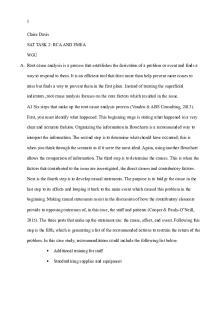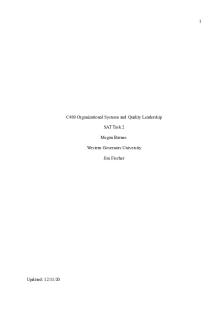AMT2 Task 2 PDF

| Title | AMT2 Task 2 |
|---|---|
| Course | Service Line Development |
| Institution | Western Governors University |
| Pages | 5 |
| File Size | 58.8 KB |
| File Type | |
| Total Downloads | 73 |
| Total Views | 145 |
Summary
Service Line Development...
Description
AMT2: Service Line Development Task 2 Ms. Ashley Tennessee Author: Sijuade Aofolaju Western governors University 01/26/2021
2 Trinity Community Hospital (TCH) conducted a needs assessment for the region that they provide health services. The assessment was widespread. The assessment was focused on cancer, cardiovascular, and orthopedic services within TCH’s service area and the surrounding areas. After reviewing the findings, they were able to identify risk factors and needs to create a health plan summary that outlines recommended actions to meet the health needs of the community it serves. A1. Risks Major risk factors identified in the assessment are lack of physicians, lack of education, facilities, and equipment. Through interviewing current physicians and other healthcare support staff, it has been found in cardiovascular, cancer, and orthopedic services that there is a lack of physicians in all service areas. There is also a need for education on cardiac risk factors, accident prevention, and overall healthy lifestyle modification. There is more space needed as well as equipment for oncology and cardiovascular service. The need for orthopedic services is for more equipment and space as well. These risks must be addressed as it has been found that there is a growing population in TCH’s service area. The assessment found that fifteen percent of the population will be over sixty-five within five years. Thirty-three percent of women and fifty percent of men are predicted to develop cancer during their lifespan. With the growing elderly population, the demand for oncology services will significantly increase in the region. The cardiac health needs identified in the assessment show an increased demand for cardiovascular services in the next five years. Patients with CAD (coronary artery disease) are
3 expected to increase by 21.6%. These cases will increase from 54,000 to 65,700. The need for lab diagnostics in the cardiac Cath lab is estimated to increase 22%; procedures will rise from 10,800 to 13,140. Also, angioplasties are projected to increase by 25.8% to 5,032 from 4,000. The community health assessment showed a need for orthopedic services within the next five years. The increased need is projected to rise in orthopedic cases by approximately 46%; this will increase cases to 17,388 from the current 11,800 cases. Inpatient joint procedures and spine procedures are projected to increase by 30%, while outpatient procedures will increase by approximately 350%. A2. Needs Trinity Community Hospital is not fully addressing all the needs identified in its need’s assessment. TCH has a five-year program plan. In this plan, they address the need for expansion. Trinity has goals and the outcomes for said goals but no plan in place of how to achieve said goals. The only area of the risk assessment addressed is the space needed for the projected increase in needed services. For the oncology center, they have a capital investment of $8,000,000 set aside. There is a capital investment set aside for the orthopedic center for expansion or purchase of a second MRI location, and $700,000 if purchased adjacent to campus or $600,000 if constructed on campus for a new physical therapy/rehab center. TCH has also set aside $4,500,000 for Cath labs and $500,000 for cardiac rehab expansion. This is the financial plan to address the lack of space needed for each service line, but there is no concrete plan to carry out every risk assessment aspect. There is no plan to address the lack of physicians, nor is
4 there a plan to put in place education programs. There are goals but no strategic plan to achieve said goal. B. Recommendation The recommendations that senior leadership has developed that will be implemented to meet the community's needs are good education programs, facilities, and equipment. The following will be implemented in thirty days and throughout the totality of the next five years. There will be reviews done yearly to assess the effectiveness of the plan. Currently, all service lines, orthopedic, cardiac, and oncology, lack an adequate program for educating its patients and the community. Education is necessary to prevent disease and vital for the understanding that patients need to know that they can modify their lifestyle for better outcomes should they be diagnosed with a condition. Education is the most cost-effective way to meet the needs of all the patients in all services. Education is the only way to combat the knowledge deficit of disease management and progression for patients in either service line. Orthopedic services’ education program will be tailored to their patients. Education provided will be focused on fitness programs that strengthen joints and muscles, education on accident prevention for the elderly during exercise and otherwise. Nutrition education will be implemented as well to prevent musculoskeletal disease and slow deterioration. The oncology education program will teach proper nutrition and lifestyle modification; it will also include education for self-examination and keeping and making regular appointments. There will be education on schedules for testing based on age and risk factors for common cancers. There will also be resources available
5 for those in need of transportation to and from appointments. Cardiac services education will be lifestyle centered. There will be an education program for risk factors, nutrition, and exercises necessary to have a healthy heart. Lifestyle modifications will be the primary education for those already diagnosed with cardiovascular disease. Education will be provided about hypertension prevention, treatments, and signs and symptoms. There will be education about cardiac arrest and its signs and symptoms; the education will include when to go to the hospital. Doctors, nurses, nutritionists, and necessary support staff will develop and maintain these programs. Free classes will be offered from each service line daily. These classes' focus will be on prevention, disease management, and the resources available for the community to use. There will be specified days for each service to educate their patients, and it will be scheduled as not to conflict with other service lines. Another recommendation is to expand and start the construction process. This will fix the risk of lack of location space. In this same process, equipment should be purchased and ready once the locations are complete. There should be a mass hiring event to hire more physicians for these new locations. There needs to be hiring of staff on all levels to prepare for the expansion....
Similar Free PDFs

AMT2 Task 2
- 5 Pages

Task 2 - Task 2
- 5 Pages

QHT1 Task 2 - Task 2
- 1 Pages

Task 2 - C226 Task 2
- 7 Pages

D082 Task 2 - Task 2
- 3 Pages

TDT1 Task 2 - Task 2
- 4 Pages

TET1 Task 2 - Task 2
- 4 Pages

DO81 - Task 2 - Task 2
- 5 Pages

C228 Task 2 - Task 2
- 6 Pages

D081 - Task 2 - Task 2
- 2 Pages

D093 Task 2 - task
- 6 Pages

Final CPC TASK 2 - task 2
- 44 Pages

Task 2
- 8 Pages

Task 2
- 10 Pages

C489 Task Two - Task 2
- 7 Pages
Popular Institutions
- Tinajero National High School - Annex
- Politeknik Caltex Riau
- Yokohama City University
- SGT University
- University of Al-Qadisiyah
- Divine Word College of Vigan
- Techniek College Rotterdam
- Universidade de Santiago
- Universiti Teknologi MARA Cawangan Johor Kampus Pasir Gudang
- Poltekkes Kemenkes Yogyakarta
- Baguio City National High School
- Colegio san marcos
- preparatoria uno
- Centro de Bachillerato Tecnológico Industrial y de Servicios No. 107
- Dalian Maritime University
- Quang Trung Secondary School
- Colegio Tecnológico en Informática
- Corporación Regional de Educación Superior
- Grupo CEDVA
- Dar Al Uloom University
- Centro de Estudios Preuniversitarios de la Universidad Nacional de Ingeniería
- 上智大学
- Aakash International School, Nuna Majara
- San Felipe Neri Catholic School
- Kang Chiao International School - New Taipei City
- Misamis Occidental National High School
- Institución Educativa Escuela Normal Juan Ladrilleros
- Kolehiyo ng Pantukan
- Batanes State College
- Instituto Continental
- Sekolah Menengah Kejuruan Kesehatan Kaltara (Tarakan)
- Colegio de La Inmaculada Concepcion - Cebu
